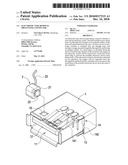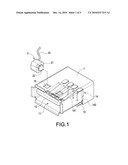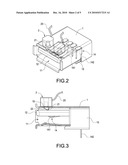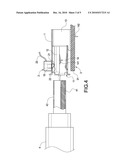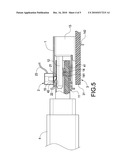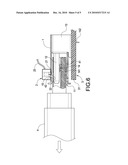Patent application title: ELECTRONIC TYPE REMOVAL PREVENTING CONNECTOR
Inventors:
Nai-Chien Chang (Sanchong City, TW)
IPC8 Class: AH01R1362FI
USPC Class:
439305
Class name: With coupling movement-actuating means or retaining means in addition to contact of coupling part including lock for retaining means (e.g., key or combination lock or requiring "special" tool) magnetically operated latch
Publication date: 2010-12-16
Patent application number: 20100317215
l preventing connector includes a joint and an
electronic switch. The joint includes a port, and at least one through
hole formed on an external surface of the joint and interconnected to the
port. At least one set of electronic switches is installed onto the
through hole, and includes a tongue passed through the through hole and
having an oblique surface. If a metal plug of a portable electronic
device is inserted into the port of the connector, the tongue of the
electronic switch will be entered into a bolt hole of the metal plug to
prevent the portable electronic device from being stolen. If the
electronic switch is electrically conducted for an operation, the tongue
will be separated from the through hole and the bolt hole, such that a
user can remove the metal plug of the portable electronic device from the
joint of the connector.Claims:
1. An electronic type removal preventing connector, electrically coupled
to a mainboard of an electronic device, and capable of locking a metal
plug of a portable electronic device inserted into a connector joint,
comprising:a joint, having a port formed thereon for inserting a plug of
the portable electronic device, and at least one through hole formed an
external surface of the joint and interconnected to a connecting hole;
andat least one set of electronic switches, installed on the through
hole, and having a tongue disposed thereon and extended and passed
through the through hole, and the tongue having an oblique surface.
2. The connector of claim 1, wherein the joint is made of a material selected from the collection of metal and plastic.
3. The connector of claim 2, wherein the port is a port of a universal serial bus (USB) connector.
4. The connector of claim 3, wherein the port includes a base therein, and the base includes a tongue plate coupled to the base, and the tongue plate includes a plurality of conducting terminals thereon, and the conducting terminal includes a contact pin and a soldered pin disposed at an end of the conducting terminal, and the contact pin is fixed onto the tongue plate, and the soldered pin is passed through the base and extended to the outside of the base.
5. The connector of claim 1, wherein the electronic switch is a solenoid valve.
6. The connector of claim 5, wherein the tongue of the solenoid valve includes a rod installed thereon, and the rod includes a magnetic line module and a spring.
7. The connector of claim 1, wherein the plug is a universal serial bus (USB) plug.
8. The connector of claim 1, wherein the electronic device is a computer.
9. The connector of claim 1, wherein the portable electronic device is a flash disk.Description:
BACKGROUND OF THE INVENTION
[0001]1. Field of the Invention
[0002]The present invention generally relates to connectors, in particular to a connector with a removal preventing structure.
[0003]2. Description of Prior Art
[0004]Universal Serial Bus (USB) is a serial bus standard used for connecting external devices and applied extensively in computers, and it has a major feature of supporting hot plug and plug-and-play functions. If a device is inserted into a USB connector, the computer system will load a driver program that is required specifically by the device, and thus the USB is much more convenient than PCI and ISA buses.
[0005]In some USB connectors, a code lock structure is installed. For example, a USB connector lock structure as disclosed in Taiwan. Pat. No. 1273161 can prevent a portable electronic device from being stolen by a thief. Although some USB connectors of desktop devices come with a code lock structure, yet not all of them have the code lock, so that if a portable electronic device is inserted into a USB connector without a code lock, there will be a risk of the portable electronic device being stolen by thieves anytime.
SUMMARY OF THE INVENTION
[0006]Therefore, it is a primary objective of the present invention to overcome the shortcomings of the prior art by providing an electronic type removal preventing connector capable of locking a portable electronic device inserted into the connector to prevent the portable electronic device from being stolen by thieves.
[0007]To achieve the foregoing objective, the present invention discloses an electronic type removal preventing connector, comprising:
[0008]a joint, having a port formed thereon, and the port having a base therein, and the base having a tongue plate, and the tongue plate having a plurality of conducting terminals, and an end of the conducting terminal having a contact pin and a soldered pin, and the contact pin being fixed at the tongue plate, and the soldered pin being passed through the base and extended to the outside of the base, and at least one through hole being formed on an external surface of the joint and interconnected to the through hole; and
[0009]an electronic switch, installed with at least one set onto the through hole, and having a tongue extended and passed through the through hole, and the tongue having an oblique surface provided for facilitating the joint of a transmission line to prop open the tongue.
BRIEF DESCRIPTION OF DRAWING
[0010]FIG. 1 is an exploded view of an electronic type removal preventing connector in accordance with the present invention;
[0011]FIG. 2 is a perspective view of an electronic type removal preventing connector in accordance with the present invention;
[0012]FIG. 3 is a cross-sectional side view of FIG. 2;
[0013]FIG. 4 is a schematic view of a using status of the present invention;
[0014]FIG. 5 is a schematic view of an operation of the present invention; and
[0015]FIG. 6 is a schematic view of an operation as depicted in FIG. 5.
DETAILED DESCRIPTION OF THE INVENTION
[0016]The detailed description and technical contents of the present invention will become apparent with the following detailed description accompanied with related drawings. It is noteworthy to point out that the drawings is provided for the illustration purpose only, but not intended for limiting the scope of the present invention.
[0017]With reference to FIGS. 1 and 2 for an exploded view and a perspective view of an electronic type removal preventing connector in accordance with the present invention respectively, the electronic type removal preventing connector comprises a joint 1 and an electronic switch 2.
[0018]The joint 1 is made of a metal or plastic material, and has a port 11 formed thereon, and the port 11 is a port for plugging a USB connector, and the port 11 contains a base 13 made of a plastic material, and the base 13 includes a tongue plate 12 coupled to the base 13, and the tongue plate 12 includes a plurality of conducting terminals 14 thereon, and an end of the conducting terminal 14 includes a contact pin 141 and a soldered pin 142, and the contact pin 141 is fixed onto the tongue plate 12, and the soldered pin 142 is passed through the base 13 and extended to the outside of the base 13, and at least one through hole 15 is formed on an external surface of the joint 1 and interconnected to the port 11.
[0019]The electronic switch 2 is a traditional solenoid valve and includes a magnetic line module and a spring installed therein, and at least one set of the electronic switches 2 is installed onto the through hole 15 and includes a tongue 21 extended and passed through the through hole 15, and the tongue 21 has an oblique surface 22 provided for facilitating a metal joint (not shown in the figure) of a transmission line to prop open the tongue 21. A magnetic line module (not shown in the figure) and a spring (not shown in the figure) are sheathed onto a rod of the tongue 21 and provided for controlling the movement of the tongue 21.
[0020]With reference to FIG. 3 for a cross-sectional side view of FIG. 2, if the electronic switch 2 is installed and coupled onto the joint 1 of the connector, the tongue 21 of the electronic switch 2 is passed through the through hole 15 of the joint 1 and disposed at the top of the tongue plate 12 of the port 11 for facilitating its locking to a joint of the transmission line inside the port 11.
[0021]With reference to FIGS. 4 to 6 for a using status, and movements of the present invention respectively, after the connector of the present invention is electrically connected to a mainboard 31 of an electronic device 3 (such as a computer), a conducting wire 23 of the electronic switch 2 is electrically connected to the mainboard 31. If a user inserts a portable electronic device 4 (such as a flash disk) with a USB metal plug 41 into the port 11 of the metal joint 1, and the USB metal plug 41 is moved along the oblique surface 22 to open the tongue 21 by propping, and the USB metal plug 41 is further pushed into a position where the tongue 21 is no longer propped, and a spring (not shown in the figure) installed in the electronic switch 2 pushes the tongue 21 back to its original position, such that the tongue 21 is entered into the bolt hole 42 formed on an external surface of the USB metal plug 41 to prevent the portable electronic device from being stolen by thieves.
[0022]When the portable electronic device 4 is not in use, a user can operate the electronic device 3, such that the mainboard 31 of the electronic device 3 outputs electric power to the electronic switch 2, and a magnetic module (not shown in the figure) installed in the electronic switch 2 produces an attraction force to drive the tongue 21 to be separated from the through hole 15 and the bolt hole 42. Now, the user can remove the USB metal plug 41 of the portable electronic device 4 from the joint 1 of the connector.
[0023]After the USB metal plug 41 of the portable electronic device 4 is unplugged and removed, the mainboard 31 will no longer supply electric power to electronic switch 2, and the spring installed inside the electronic switch 2 will push the tongue 21 back to its original position.
[0024]While the invention has been described by means of specific embodiments, numerous modifications and variations could be made thereto by those skilled in the art without departing from the scope and spirit of the invention set forth in the claims.
Claims:
1. An electronic type removal preventing connector, electrically coupled
to a mainboard of an electronic device, and capable of locking a metal
plug of a portable electronic device inserted into a connector joint,
comprising:a joint, having a port formed thereon for inserting a plug of
the portable electronic device, and at least one through hole formed an
external surface of the joint and interconnected to a connecting hole;
andat least one set of electronic switches, installed on the through
hole, and having a tongue disposed thereon and extended and passed
through the through hole, and the tongue having an oblique surface.
2. The connector of claim 1, wherein the joint is made of a material selected from the collection of metal and plastic.
3. The connector of claim 2, wherein the port is a port of a universal serial bus (USB) connector.
4. The connector of claim 3, wherein the port includes a base therein, and the base includes a tongue plate coupled to the base, and the tongue plate includes a plurality of conducting terminals thereon, and the conducting terminal includes a contact pin and a soldered pin disposed at an end of the conducting terminal, and the contact pin is fixed onto the tongue plate, and the soldered pin is passed through the base and extended to the outside of the base.
5. The connector of claim 1, wherein the electronic switch is a solenoid valve.
6. The connector of claim 5, wherein the tongue of the solenoid valve includes a rod installed thereon, and the rod includes a magnetic line module and a spring.
7. The connector of claim 1, wherein the plug is a universal serial bus (USB) plug.
8. The connector of claim 1, wherein the electronic device is a computer.
9. The connector of claim 1, wherein the portable electronic device is a flash disk.
Description:
BACKGROUND OF THE INVENTION
[0001]1. Field of the Invention
[0002]The present invention generally relates to connectors, in particular to a connector with a removal preventing structure.
[0003]2. Description of Prior Art
[0004]Universal Serial Bus (USB) is a serial bus standard used for connecting external devices and applied extensively in computers, and it has a major feature of supporting hot plug and plug-and-play functions. If a device is inserted into a USB connector, the computer system will load a driver program that is required specifically by the device, and thus the USB is much more convenient than PCI and ISA buses.
[0005]In some USB connectors, a code lock structure is installed. For example, a USB connector lock structure as disclosed in Taiwan. Pat. No. 1273161 can prevent a portable electronic device from being stolen by a thief. Although some USB connectors of desktop devices come with a code lock structure, yet not all of them have the code lock, so that if a portable electronic device is inserted into a USB connector without a code lock, there will be a risk of the portable electronic device being stolen by thieves anytime.
SUMMARY OF THE INVENTION
[0006]Therefore, it is a primary objective of the present invention to overcome the shortcomings of the prior art by providing an electronic type removal preventing connector capable of locking a portable electronic device inserted into the connector to prevent the portable electronic device from being stolen by thieves.
[0007]To achieve the foregoing objective, the present invention discloses an electronic type removal preventing connector, comprising:
[0008]a joint, having a port formed thereon, and the port having a base therein, and the base having a tongue plate, and the tongue plate having a plurality of conducting terminals, and an end of the conducting terminal having a contact pin and a soldered pin, and the contact pin being fixed at the tongue plate, and the soldered pin being passed through the base and extended to the outside of the base, and at least one through hole being formed on an external surface of the joint and interconnected to the through hole; and
[0009]an electronic switch, installed with at least one set onto the through hole, and having a tongue extended and passed through the through hole, and the tongue having an oblique surface provided for facilitating the joint of a transmission line to prop open the tongue.
BRIEF DESCRIPTION OF DRAWING
[0010]FIG. 1 is an exploded view of an electronic type removal preventing connector in accordance with the present invention;
[0011]FIG. 2 is a perspective view of an electronic type removal preventing connector in accordance with the present invention;
[0012]FIG. 3 is a cross-sectional side view of FIG. 2;
[0013]FIG. 4 is a schematic view of a using status of the present invention;
[0014]FIG. 5 is a schematic view of an operation of the present invention; and
[0015]FIG. 6 is a schematic view of an operation as depicted in FIG. 5.
DETAILED DESCRIPTION OF THE INVENTION
[0016]The detailed description and technical contents of the present invention will become apparent with the following detailed description accompanied with related drawings. It is noteworthy to point out that the drawings is provided for the illustration purpose only, but not intended for limiting the scope of the present invention.
[0017]With reference to FIGS. 1 and 2 for an exploded view and a perspective view of an electronic type removal preventing connector in accordance with the present invention respectively, the electronic type removal preventing connector comprises a joint 1 and an electronic switch 2.
[0018]The joint 1 is made of a metal or plastic material, and has a port 11 formed thereon, and the port 11 is a port for plugging a USB connector, and the port 11 contains a base 13 made of a plastic material, and the base 13 includes a tongue plate 12 coupled to the base 13, and the tongue plate 12 includes a plurality of conducting terminals 14 thereon, and an end of the conducting terminal 14 includes a contact pin 141 and a soldered pin 142, and the contact pin 141 is fixed onto the tongue plate 12, and the soldered pin 142 is passed through the base 13 and extended to the outside of the base 13, and at least one through hole 15 is formed on an external surface of the joint 1 and interconnected to the port 11.
[0019]The electronic switch 2 is a traditional solenoid valve and includes a magnetic line module and a spring installed therein, and at least one set of the electronic switches 2 is installed onto the through hole 15 and includes a tongue 21 extended and passed through the through hole 15, and the tongue 21 has an oblique surface 22 provided for facilitating a metal joint (not shown in the figure) of a transmission line to prop open the tongue 21. A magnetic line module (not shown in the figure) and a spring (not shown in the figure) are sheathed onto a rod of the tongue 21 and provided for controlling the movement of the tongue 21.
[0020]With reference to FIG. 3 for a cross-sectional side view of FIG. 2, if the electronic switch 2 is installed and coupled onto the joint 1 of the connector, the tongue 21 of the electronic switch 2 is passed through the through hole 15 of the joint 1 and disposed at the top of the tongue plate 12 of the port 11 for facilitating its locking to a joint of the transmission line inside the port 11.
[0021]With reference to FIGS. 4 to 6 for a using status, and movements of the present invention respectively, after the connector of the present invention is electrically connected to a mainboard 31 of an electronic device 3 (such as a computer), a conducting wire 23 of the electronic switch 2 is electrically connected to the mainboard 31. If a user inserts a portable electronic device 4 (such as a flash disk) with a USB metal plug 41 into the port 11 of the metal joint 1, and the USB metal plug 41 is moved along the oblique surface 22 to open the tongue 21 by propping, and the USB metal plug 41 is further pushed into a position where the tongue 21 is no longer propped, and a spring (not shown in the figure) installed in the electronic switch 2 pushes the tongue 21 back to its original position, such that the tongue 21 is entered into the bolt hole 42 formed on an external surface of the USB metal plug 41 to prevent the portable electronic device from being stolen by thieves.
[0022]When the portable electronic device 4 is not in use, a user can operate the electronic device 3, such that the mainboard 31 of the electronic device 3 outputs electric power to the electronic switch 2, and a magnetic module (not shown in the figure) installed in the electronic switch 2 produces an attraction force to drive the tongue 21 to be separated from the through hole 15 and the bolt hole 42. Now, the user can remove the USB metal plug 41 of the portable electronic device 4 from the joint 1 of the connector.
[0023]After the USB metal plug 41 of the portable electronic device 4 is unplugged and removed, the mainboard 31 will no longer supply electric power to electronic switch 2, and the spring installed inside the electronic switch 2 will push the tongue 21 back to its original position.
[0024]While the invention has been described by means of specific embodiments, numerous modifications and variations could be made thereto by those skilled in the art without departing from the scope and spirit of the invention set forth in the claims.
User Contributions:
Comment about this patent or add new information about this topic:

